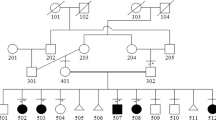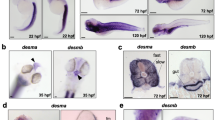Abstract
MYOGENIN is a member of the basic helix-loop-helix (bHLH) gene family and converts multipotential mesodermal cells to myoblasts1–4. The four members of the myoD family show unique spatio-temporal expression patterns5 and therefore may have different functions during myogenesis. Here we inactivate the myogenin gene in order to understand its role in myogenesis. Homozygous mutations are lethal perinatally owing to the resulting major defects in skeletal muscle. The extent of disorganization of muscle tissue differs in three regions. In the latero-ventral body wall, most cells, including myogenic cells, disappear and there is rapid accretion of fluid. In the limbs, cells of the myogenic lineage exist, but they are severely disrupted, and some of them are mono-nucleate with properties of myoblasts. In contrast, there are many axial, intercostal and back muscle fibres to be seen, although fibres are mainly disorganized and Z-lines are not present in most myofibrils. These findings are evidence that myogenin is crucial for muscle development in utero and demonstrate that other members of the myogenic gene family cannot compensate for the defect.
This is a preview of subscription content, access via your institution
Access options
Subscribe to this journal
Receive 51 print issues and online access
$199.00 per year
only $3.90 per issue
Buy this article
- Purchase on Springer Link
- Instant access to full article PDF
Prices may be subject to local taxes which are calculated during checkout
Similar content being viewed by others
References
Davis, R. L., Weintraub, H. & Lassar, A. B. Cell 51, 987–1000 (1987).
Wright, W. E., Sassoon, D. A. & Lin, V. K. Cell 56, 607–617 (1989).
Braun, T., Buschhausen, D. G., Bober, E., Tannich, E., & Arnold, H. H. EMBO J. 8, 701–709 (1989).
Rhodes, S. J. & Konieczny, S. F. Genes Dev. 3, 2050–2061 (1989).
Lyons, G. E. & Buckingham, M. E. Sem. dev. Biol. 3, 243–253 (1992).
Mansour, S. L., Thomas, K. R. & Capecchi, M. R. Nature 336, 348–352 (1988).
Weintraub, H. et al. Science 251, 761–766 (1991).
Sassoon, D. et al. Nature 341, 303–307 (1989).
Miller, J. B. Neuromusc. Dis. 1, 7–17 (1991).
Ordahl, C. P. & Le Douarin, N. M. Development 114, 339–353 (1992).
Ede, D. & El-Gadi, A. in Somites in Developing Embryos (eds Ballairs, R. D. & Lassh, J.) 209–224 (Plenum, New York, 1986).
Milaire, J. Archs Biol. 87, 315–343 (1976).
Keynes, R. & Stern, C. Development 103, 413–429 (1988).
Cusella-De Angelis, M. et al. J. Cell Biol. 116, 1243–1255 (1992).
Olsen, E. N. Devl Biol. 154, 261–272 (1992).
Li, L. et al. Cell 71, 1181–1194 (1992).
Tapscott, S. J. et al. Science 242, 405–411 (1988).
Brennan, T. J., Edmondson, D. G., Li, L. & Olson, E. N. Proc. natn. Acad. Sci. U.S.A. 88, 3822–3826 (1991).
Rudnicki, M. A., Braun, T., Hinuma, S. & Jaenisch R. Cell 71, 383–390 (1992).
Braun, T., Rudnicki, M. A., Arnold, H. H. & Jaenisch, R. Cell 71, 369–382 (1992).
Katoh, K., Takahashi, Y., Hayashi, S. & Kondoh, H. Cell Struct. Funct. 12, 575–580 (1987).
Handyside, A. H., O'Neill, G. T., Jones, M. & Hooper, M. L. Roux's Arch. Dev. Biol. 198, 48–55 (1989).
Sawai, S., Shimono, A., Hanaoka, K. & Kondoh, H. New Biol. 3, 861–869 (1991).
Abe, H., Komiya, T. & Obinata, T. Devl Biol. 118, 42–51 (1989).
Fujisawa-Sehara, A. et al. J. biol. Chem. 267, 10031–10038 (1992).
Kim, D. W., Uetsuki, T., Kaziro, Y., Yamaguchi, N. & Sugano, S. Gene 9, 217–223 (1990).
Author information
Authors and Affiliations
Rights and permissions
About this article
Cite this article
Nabeshima, Y., Hanaoka, K., Hayasaka, M. et al. Myogenin gene disruption results in perinatal lethality because of severe muscle defect. Nature 364, 532–535 (1993). https://doi.org/10.1038/364532a0
Received:
Accepted:
Issue Date:
DOI: https://doi.org/10.1038/364532a0
Comments
By submitting a comment you agree to abide by our Terms and Community Guidelines. If you find something abusive or that does not comply with our terms or guidelines please flag it as inappropriate.



